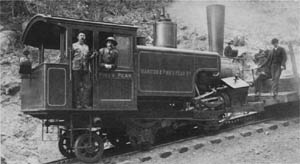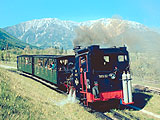Cog railway
|
|
Lausanne_Metro_Track_Closeup.jpg
A cog railway or rack-and-pinion railway is a mountain railway with a special centre rack rail mounted in the middle of the sleepers between the regular rails. The trains are fitted with one or more cog wheels that mesh into this rack rail. This then allows the locomotives to haul the train up steeply inclined slopes.
| Contents |
Rack systems
A number of different rack systems have been developed:
- The Riggenbach system uses a ladder rack, formed of steel plates connected by round bars at regular intervals. The Riggenbach system was the first system devised, and suffers from the problem that its fixed rack is much more complex and expensive to build than the other systems. This system is sometimes known as the Marsh system, because of simultaneous invention by an American inventor, Syvester Marsh, builder of the Mount Washington railroad.
- The Abt system was devised by Roman Abt, a Swiss locomotive engineer working for a Riggenbach-equipped line, as an improved rack system. An Abt rack features steel plates mounted vertically and in parallel to the rails, with rack teeth machined to a precise profile in them. These engage with the locomotive's pinion teeth much more smoothly than the Riggenbach system. Two or three parallel sets of Abt rack plates are used, with a corresponding number of driving pinions on the locomotive, to ensure that at least one pinion tooth is always engaged securely.
- The Strub system is similar to the Abt but uses just one row of wider rack plate. It is the simplest rack system to maintain and has become increasingly popular.
- The Locher system involves gear teeth cut in the sides rather than the top of the rail, engaged by two cog wheels on the locomotive. This system allows use on steeper grades than the other systems, whose teeth could jump out of the rack. It is used on the Mount Pilatus railway.
- The Fell system (not actually a rack system) uses a raised centre rail that is gripped by a mechanism on the engine.
The vast majority of cog railways use the Abt system.
Some rail systems, known as 'rack-and-adhesion', use the cog drive only on the steepest sections and elsewhere operate like a regular railway. Others are rack-only. On the latter type, the locomotives' wheels are generally free-wheeling and despite appearances do not contribute to driving the train.
Cog locomotives
Originally, almost all cog railways were powered by steam locomotives. The steam locomotive needs to be extensively modified to work effectively in this environment. Unlike a diesel locomotive or electric locomotive, the steam locomotive only works when its powerplant (the boiler, in this case) is fairly level. The locomotive boiler requires water to cover the boiler tubes and firebox sheets at all times, particularly the crown sheet, the metal top of the firebox. If this is not covered with water, the heat of the fire will melt it, until it softens enough to give way under the boiler pressure, leading to a catastrophic failure.
On rack systems with extreme gradients, the boiler, cab and general superstructure of the locomotive are tilted forward relative to the wheels, so that it is more or less horizontal when placed on the steeply graded track of the railway. These locomotives often cannot function on level track, and so the entire line must be laid on a gradient, including maintenance shops.
On a rack-only railroad locomotives always push their passenger cars, for safety reasons since the locomotive is fitted with powerful brakes including, often, hooks or clamps that grip the rack rail solidly. Some locomotives are fitted with automatic brakes that apply if the speed gets too high, preventing runaways. Often there is no coupler between locomotive and train since gravity will always push the passenger car down against the locomotive.
List of cog and rack railways
Australia
- West Coast Wilderness Railway in Tasmania, originally opened in 1896 to service a mine, re-opened for tourists in 2003. Uses Abt system.
- Mt Morgan - rack system existed until 1950s untill deviated.
- SkiTube - in Snowy Mountains.
Austria
Brazil
Germany
France
Hungary
- Fogaskerekű Vasút in Budapest, Hungary is a kind of cog-wheel tram in the rangy Buda part of the city.
India
Italy
New Zealand
- near Wellington - until the 1950s when replaced by a tunnel, a Fell (non-rack) system operated.
Spain
Switzerland
- Berner Oberland Bahn
- Jungfraubahn
- Luzern-Stans-Engelberg-Bahn
- Monte Generoso Railway
- Pilatus Railway
- Schynige Platte Railway
- Wengernalpbahn
United Kingdom
United States
See Also
- Fell railway (friction wheels)
- Funicular
- Rack and pinion
da:Tandhjulsbane de:Zahnradbahn fr:Chemin de fer à crémaillère nl:Tandradspoorweg zh:齒軌鐵路 sv:Kuggstångsbana


